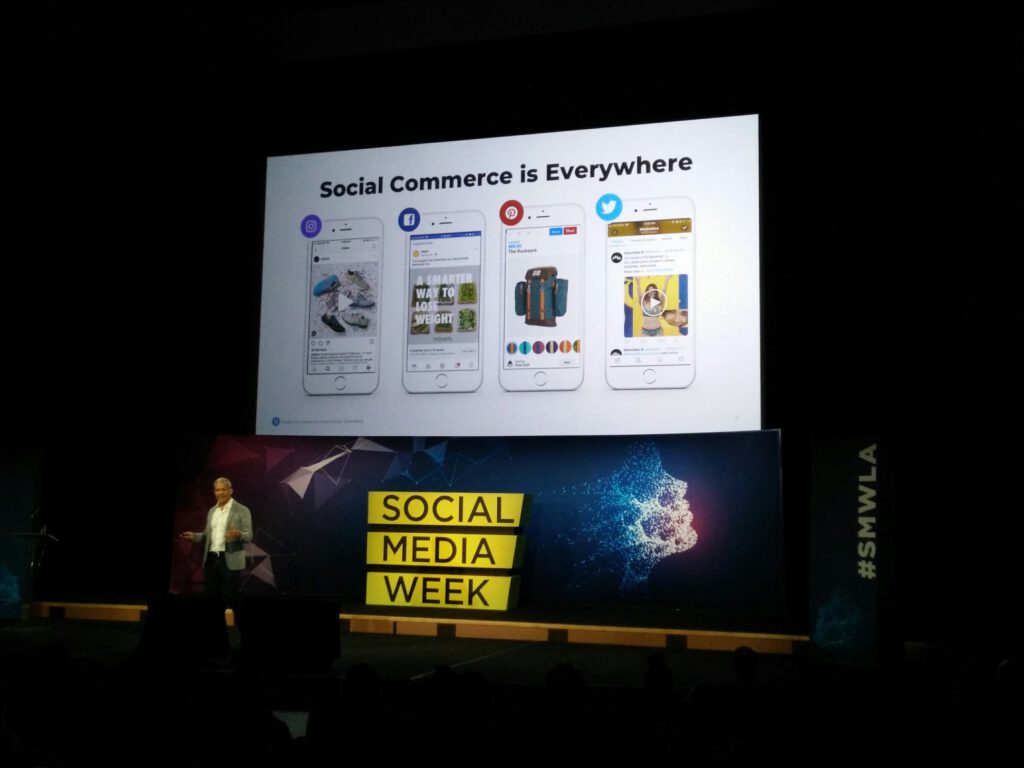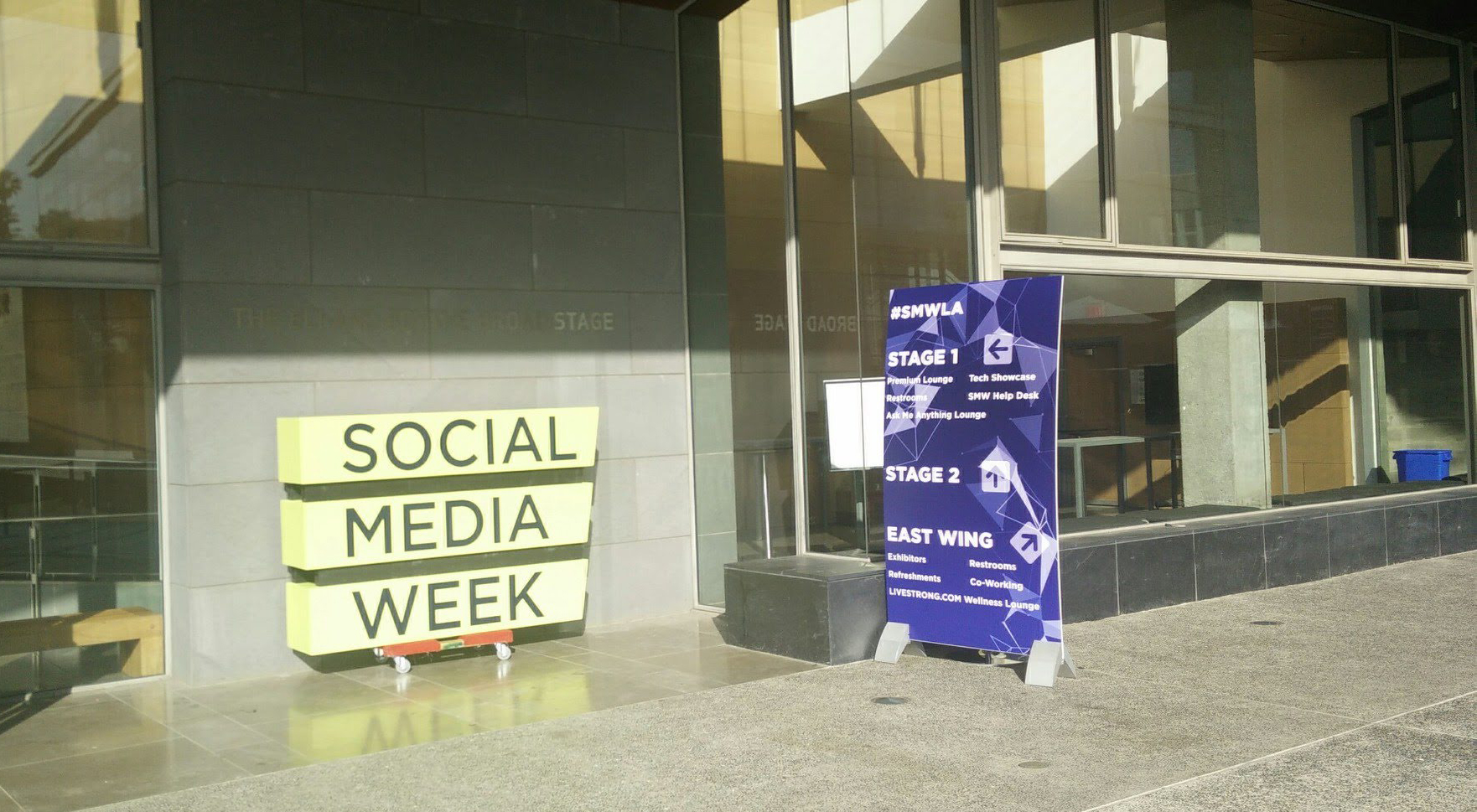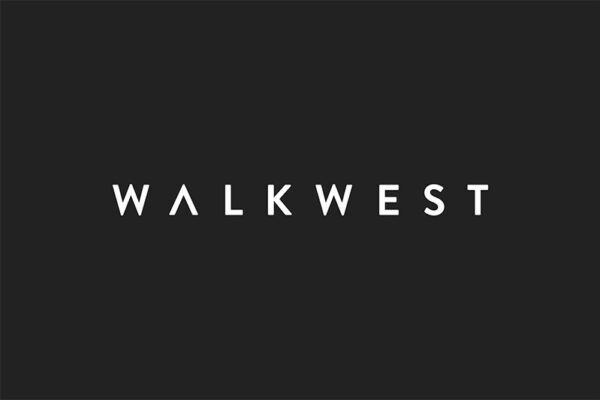
Have a curiosity and passion for new ideas, innovation, and emerging trends in social media? Me too! I was so excited when Walk West gave me the opportunity to spend the week in Los Angeles with other thought leaders in the space to discuss what’s next in our industry at Social Media Week.
I love everything about social media marketing, especially the quick change of pace that comes with being in this industry. With everything constantly evolving, it’s critical to keep up with the latest trends and strategies. What took the conference to the next level for me were the connections I made. The conference was brilliantly set up so that all of speakers were easy to interact with, as each had a live Q&A session directly after they got off stage.
This allowed me to meet some truly impressive leaders of ecommerce, marketing, and social media from all across the US. I was able to meet Adam Quinn, the VP of Digital at National Geographic, and hear his thoughts on the incredible power of social storytelling. I engaged in a candid, insightful conversation on why so many businesses fail by focusing on rigidity instead of flexibility with Jeremy Lowe, Senior Marketing and Digital Strategy Manager for Dick Clark Productions.
These were just a couple of the experts I was able to get up close and personal with. At every lunch or coffee break, I met a new person who shared their story or asked me to give them insights on a social barrier they are facing. Once the conference concluded, I could not wait to come back to my team and shared all that I learned. Here are just 6 of the many takeaways from Social Media Week.
1. Integrate Data and Creative
The session ‘Building the Agency of the Future’ explored how failing to integrate data-driven insights with the creative process is one of the most common mistakes that marketers make. Your data should equally inform both media and creative briefs, bridging the gap between code, copy, and design.
When you utilize the same data insights to design the right creative elements, you will reach your consumers — wherever they are on the buyer’s journey.
Creative without data is ineffective and data without creative is irrelevant. Businesses that can seamlessly integrate data and creative with purpose will outpace the ones that only excel at one.
After the session, I was able to connect with Jean Freeman, owner and CEO of Zambezi, a company that has been recognized as one of the largest women-owned businesses.
2. Evolve
Katrina Lake, the CEO of Stitchfix, said “I’m doing something different every year. If I’m not, I’m failing in my job. That’s how you grow and scale a company for the future… by having an interactive approach and growth process.”
Business should stop replicating tactics that have worked in the past – whether it was last week, last month, or last year – nor should they be focusing too heavily on what their competitors are doing on social media. What worked for your business or competitor a year or even a couple months ago, will not have the same success rate in the future.
3. Facebook Post-Algorithm Change
While Facebook algorithm updates have been happening for years, Facebook’s newest changes will affect every single business on the platform. Even those that have a solid social strategy in place.
This means that it’s essential for you take a closer look at your current Facebook strategy. If you’ve noticed a huge dip in traffic, it’s time to take a different approach. While everyone loses in this scenario, you can mitigate the loss of potential business by adapting the way you behave on the platform. Basically, act more like a person, instead of a business.
Here are some quick tips that were shared:
- Refrain from using engagement bait tactics (example: ‘tag a friend below’, ‘Comments welcome!’)
- Utilize buyer persona data to refine your content. Focus on what it is your customers need. What solution do you provide to meet their challenges?
- Turn to video content. Videos generate 1200% more shares than text and images on Facebook. (https://www.wordstream.com/blog/ws/2017/03/08/video-marketing-statistics)
- Be more strategic in advertising. If you aren’t using Facebook ads, now might be the time to start. If you are using them, now might be the time to optimize to scale.
4. Take Risks
Postmates is a logistics company that operates a network of couriers who deliver goods locally. Their first awareness campaign was risky. But, they made the initial foundation by marrying data and creative first. Postmates started by using social listening online in the LA area to determine how people were talking about food, groceries, and other services.
They used this data to design sarcastic and edgy-yet-humorous billboards, focusing on the younger generations as the target audience. They took a huge risk by deciding to only advertise through this traditional media campaign.
However, it was worth the gamble, as thousands of user-generated content posts (free advertising) rolled in from people sharing pictures of the ads, which played a vital role in the success of Postmates today. In fact, in a poll asking how people learned of Postmates, 52% said they saw a post online from someone they were following on social. So in the end, taking the risky move to advertise in traditional media led to a massive digital following and huge spike in sales and revenue.
Companies who are afraid of venturing into the unknown fail to inspire and create the innovation they often want, but with the right data-driven insights, the unknown doesn’t have to be so unfamiliar.
5. Embrace Change
Pivots are a part of the norm in this highly-connected world. Be open to change within the organization to push your company forward and shift your business model to meet what your customers/clients need, when they need it.
Google goes through a company reorganization every 2-3 years to shake things up. Amazon regularly goes through massive organizational changes when developing new business opportunities. These companies are willing to make drastic changes and iterations to their business model, because they realize change is fundamental to growing a business.
6. Influencers Still Matter
Authenticity remains one of the most important aspects for a successful social strategy. A common misconception is that influencers are for Big brands, but every business has advocates. Even emerging brands who don’t have the massive horde of followers that a celebrity or established influencer may have can still be incredibly successful. Smaller influencers who like your brand often have a more engaged following because they are seen as more authentic.
So if you’re new to influencer marketing, how do you get started? Here are a few simple tips:
- Make a list of influencers in your vertical.
- Follow them. Follow what they are saying, and follow the responses they are getting.
- Interact with their audience if it’s appropriate. Don’t be afraid to get involved. It makes you seem more real and approachable.
- Don’t just reach out with a random piece of content hoping for the best.
- Be patient. It takes time to develop good relationships with influencers organically.
Influencers are some of the greatest content creators in the world. They help to generate conversations beyond likes. They get people talking, and people trust them. If you can harness that trust, your business will soar.
The social landscape is moving and ever-evolving, so it’s critical that you are ahead of the curve. The evolution of computers has vastly increased the speed at which innovation and communication occurs. What used to take months now takes days, or maybe hours.
Here at Walk West, we have a team of social media experts that are passionate about pushing innovative ideas to grow your business. We are dedicated to learning new tactics to bring to our clients, there are always new opportunities to approach social differently for your business. Have questions? Contact us!


